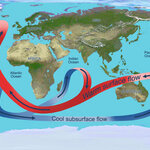Oceanography

PASADENA, Calif. - New NASA measurements of the Atlantic Meridional Overturning Circulation, part of the global ocean conveyor belt that helps regulate climate around the North Atlantic, show no significant slowing over the past 15 years. The data suggest the circulation may have even sped up slightly in the recent past.
The findings are the result of a new monitoring technique, developed by oceanographer Josh Willis of NASA's Jet Propulsion Laboratory in Pasadena, Calif., using measurements from ocean-observing satellites and profiling floats. The findings are reported in the March 25 issue…

Satellite measurements of the Atlantic Meridional Overturning Circulation (AMOC), part of the global ocean conveyor belt that helps regulate climate around the North Atlantic, show no significant slowing over the past 15 years and suggest that the circulation may have even sped up slightly in the recent past.
The findings are the result of a new monitoring technique, developed by oceanographer Josh Willis of NASA's Jet Propulsion Laboratory in Pasadena, Calif., using measurements from ocean-observing satellites and profiling floats.
The latest climate models predict the overturning…

Increased amounts of nitrous oxide (N2O) produced in low-oxygen (hypoxic) waters can elevate concentrations in the atmosphere, further exacerbating the impacts of global warming and contributing to ozone "holes", according to a new article published this week in Science.
"As the volume of hypoxic waters move towards the sea surface and expands along our coasts, their ability to produce the greenhouse gas nitrous oxide increases," explains Dr. Codispoti of the UMCES Horn Point Laboratory. "With low-oxygen waters currently producing about half of the ocean's net nitrous oxide, we could…

Scientists writing this week in Geophysical Research Letters say they have pinpointed six spots on the remote Pacific Antarctic Ridge, 1,000 miles from the west coast of Antarctica, where they think hydrothermal vents are likely to be found.
Two pieces of evidence tipped researchers off to the location of the hidden vents. First, the ocean is stratified with layers of lighter water sitting on top of layers of denser water. Second, when a seafloor vent erupts, it spews gases rich in rare helium-3, an isotope found in earth's mantle and in the magma bubbling below the vent. As helium-3…

A three-year field program now underway is measuring carbon distributions and primary productivity in the Northwest Atlantic Ocean to help determine the impacts of a changing climate on ocean biology and biogeochemistry. The study will also help validate ocean color satellite measurements and refine biogeochemistry models of ocean processes.
Researchers from NOAA, NASA and Old Dominion University are collaborating through an existing NOAA Fisheries Service field program, the Ecosystem Monitoring or EcoMon program. The EcoMon surveys are conducted six times each year by the Northeast Fisheries…

Subtropical waters are reaching Greenland's glaciers and likely triggering an acceleration of ice loss, reports a team of researchers from the Woods Hole Oceanographic Institution (WHOI) and the University of Maine.
"This is the first time we've seen waters this warm in any of the fjords in Greenland," says Fiamma Straneo, a physical oceanographer from the WHOI. "The subtropical waters are flowing through the fjord very quickly, so they can transport heat and drive melting at the end of the glacier."
While melting due to warming air temperatures is a known event, scientists are just beginning…
Researchers have developed a novel method for reconstructing past ocean chemistry using calcium carbonate veins that precipitate from seawater-derived fluids in rocks beneath the seafloor. The new method will help scientists analyze past changes in climate, plate tectonics and evolution of life in the oceans. The research is detailed in a paper published online in Science.
"These processes affect ocean chemistry and have shaped our planet over millions of years," said Dr Rosalind Coggon, a professor Imperial College London.
Calcium carbonate veins record the chemical evolution of seawater as…

An article at the Science Codex requests "Less hyperbole, please: Sea level has been rising and falling for the last 2,500 years". The tone is set with the opening quote from an Israeli researcher:
"Rising and falling sea levels over relatively short periods do not indicate long-term trends. An assessment of hundreds and thousands of years shows that what seems an irregular phenomenon today is in fact nothing new."
And your point is????
Are they seriously suggesting that predictions of future sea-level rise are simple extrapolations of recent sea-level rises? Have they had their heads…

A group of marine organisms called Echinoderms, which includes starfish and sea urchin, has a significant impact on the levels of carbon dioxide in the Earth's atmosphere and that influence has been greatly underestimated by scientists, argues a new paper in Ecological Monographs.
"Climate models must take this carbon sink into account," says Mario Lebrato, lead author of the study. Globally, the seabed habitats occupy more than 300 million million square metres, from the intertidal flats and pools to the mightiest deep-sea trenches at 11,000 meters. The benthos – the animals living on and…
Scientists have recorded the deepest erupting volcano yet discovered--West Mata Volcano--located 4,000 feet below the surface of the Pacific Ocean, in an area bounded by Fiji,Tonga and Samoa.
The imagery includes large molten lava bubbles three feet across bursting into cold seawater, glowing red vents exploding lava into the sea, and the first-observed advance of lava flows across the deep-ocean floor. Sounds of the eruption were recorded by a hydrophone and later matched with the video footage.
Expedition scientists released the video and discussed their observations at a Dec. 17 news…